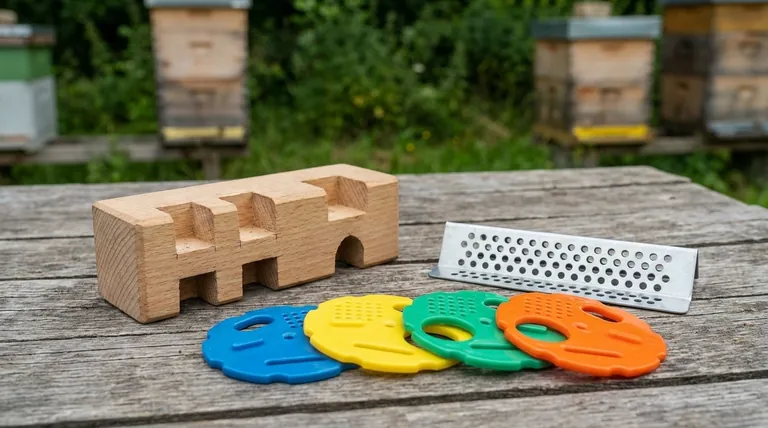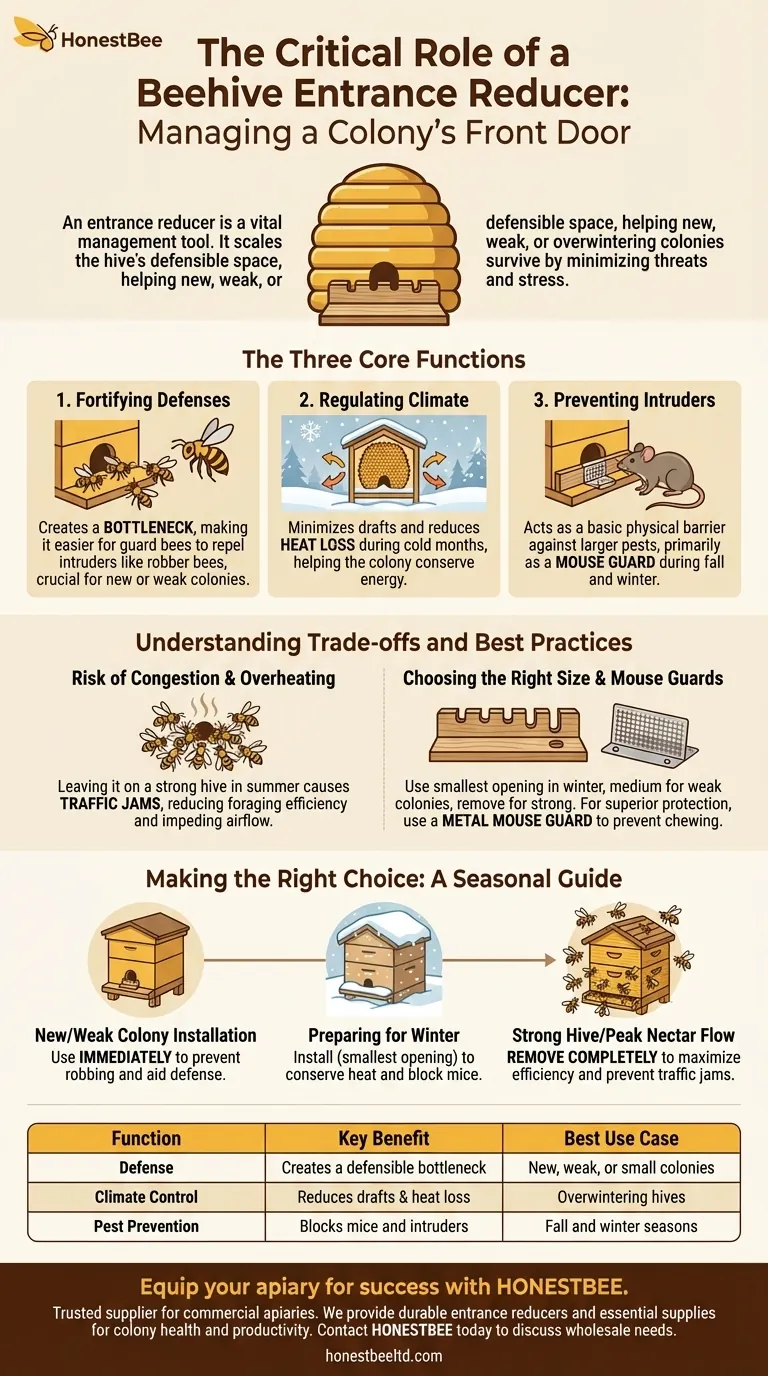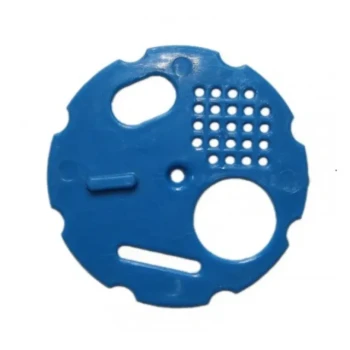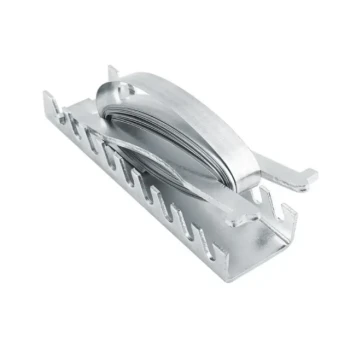At its core, a beehive entrance reducer is a simple tool for managing a colony's biggest vulnerability: its front door. This small piece of wood, placed on the bottom board, shrinks the size of the hive's main opening. Its primary functions are to help the bees defend their home from predators and robbers, regulate the internal hive temperature, and prevent pests from entering.
The true purpose of an entrance reducer is to scale the hive's defensible space to match the colony's current strength. It's a critical management tool for helping new, weak, or overwintering colonies survive by minimizing external threats and environmental stress.

The Three Core Functions of an Entrance Reducer
Understanding why this simple block of wood is so effective comes down to three key principles of hive management: defense, climate control, and pest prevention.
Fortifying the Hive's Defenses
A standard hive entrance is quite large, which is efficient for a strong, populous colony but presents a significant security risk for a smaller one.
A reduced entrance creates a bottleneck, making it far easier for a small force of guard bees to repel intruders. This is especially critical for preventing robber bees from stronger nearby hives from entering and stealing honey.
This defensive support is most crucial when first establishing a colony, as a new package or small nucleus hive has a low population and cannot defend a full-sized entrance.
Regulating the Internal Climate
Bees work constantly to maintain a stable temperature inside the hive, fanning their wings to cool it in summer and clustering for warmth in winter.
A large, open entrance can lead to significant heat loss during the cold months, forcing the winter cluster to burn through more honey stores to stay warm.
By reducing the opening, you minimize drafts and help the colony conserve precious energy and resources throughout the winter.
Preventing Unwanted Intruders
The reducer also serves as a basic physical barrier against larger pests.
Its most common use in this regard is as a mouse guard. During the fall and winter, mice often seek warm, sheltered places to nest, and a beehive is an ideal target. A reducer can block them from gaining entry.
Understanding the Trade-offs and Best Practices
An entrance reducer is a powerful tool, but using it incorrectly can harm the colony. Its application must adapt to the season and the hive's specific condition.
The Risk of Congestion and Overheating
Leaving a reducer on a strong, booming hive during a summer nectar flow is a common mistake.
The small opening creates a traffic jam for foragers, reducing their efficiency and slowing the collection of nectar. This congestion can also impede airflow, making it harder for the bees to ventilate the hive on hot days.
Choosing the Right Opening Size
Most entrance reducers are rectangular bars with different-sized notches cut into them, offering flexibility.
A common practice is to use the smallest opening during deep winter, a medium opening for a new or weak colony, and remove it entirely for a strong colony during summer.
Reducer vs. Dedicated Mouse Guard
While a wooden reducer helps deter mice, it is not foolproof. A determined mouse can and will chew through the wood.
For superior protection, a metal mouse guard is the recommended tool. These guards have holes large enough for bees but too small for mice, offering a more permanent and durable solution.
Making the Right Choice for Your Hive
Properly using an entrance reducer is about responding to your colony's needs as they change throughout the year.
- If you are installing a new or weak colony: Use the entrance reducer immediately to prevent robbing and help the small population defend its home.
- If you are preparing for winter: Install the reducer (often to its smallest opening) after the weather cools to conserve heat and block mice.
- If your hive is strong and in peak nectar flow: Remove the reducer completely to maximize foraging efficiency and prevent traffic jams at the entrance.
Ultimately, viewing the entrance reducer as a seasonal management tool, not a permanent fixture, is the key to supporting a thriving colony.
Summary Table:
| Function | Key Benefit | Best Use Case |
|---|---|---|
| Defense | Creates a defensible bottleneck for guard bees | New, weak, or small colonies |
| Climate Control | Reduces drafts and heat loss in winter | Overwintering hives |
| Pest Prevention | Blocks entry for mice and other intruders | Fall and winter seasons |
Equip your apiary for success with HONESTBEE.
As a trusted supplier for commercial apiaries and beekeeping equipment distributors, we provide the durable, high-quality entrance reducers and other essential supplies your operation needs to protect colony health and maximize productivity.
Let our wholesale-focused operations support your business. Contact HONESTBEE today to discuss your equipment needs and place your order.
Visual Guide

Related Products
- Multi-Functional Rotary Hive Entrance Disc for Beekeeping
- Multi-Functional Sliding Hive Entrance for Beekeeping
- Reusable Clear Small Hive Beetle Traps for Beehives Beetle Trapping Tools
- Professional Bamboo Queen Isolation Cage
- Australian Pine Wood Langstroth Screen Bottom Board for Wholesale
People Also Ask
- How does the outer cover create an upper entrance? Master Hive Ventilation & Congestion Control
- What is the purpose of the steel entrance disc? Master Hive Traffic Control & Security
- What are the applications of the steel entrance disc? A Beekeeper's Guide to Hive Control
- How does entrance configuration vary seasonally for beekeepers? A Guide to Year-Round Hive Health
- What are the adjustable functions of the circular metal beehive entrance disc? Master Hive Access Control



















